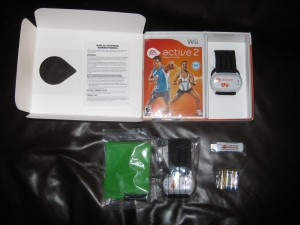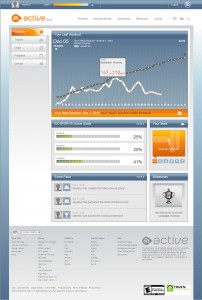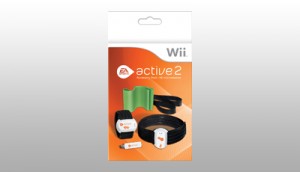Jillian Michaels Fitness Ultimatum 2011
Reviewed by Nutwiisystem on December 9.
Summary: Not a stellar sequel to an already-disappointing series.

For those of you who tried Ultimatum 2010 (and who suffered through Ultimatum 2009), this game is a completely different beast. While those were more “pure” exercise games with Jillian taking you through a bunch of exercises, here they decided to wrap the exercises around a story. Specifically, you’re a secret agent that’s helping Jillian destroy the evil corporation FPF (which produces processed foods to poison the masses) and the evil corporation CureAll (which produces a chemically-based elixir that makes people who eat FPF’s food “feel better”). Even as far as video game stories go, this one is kind of weak, but I figured I’d give them a pass on it, since the focus is on the fitness.
You start out the game doing “training”, which is essentially a series of stretching exercises. Each is worth 50-100 “points”. You need to collect 500 points in order to start the “missions”. Problem is, there’s no visual indication of the number of points you’ve collected after you finish an exercise–you just see the “Start” button again and again. After a while I figured out to go back, where I saw the “Mission” button unlocked.
The exercises themselves are okay, but nothing earth-shattering. I did like how they incorporated the “360 camera angle rotation” from the 2010 version, so you can see exactly how your on-screen character is doing the exercise. Unfortunately, the annoyances far, far outweigh anything positive. It honestly felt like I spent more time calibrating the Wii Balance Board and the Wii MotionPlus than I did actually playing the game. One thing that 2009 and 2010 had in common was horrible motion control detection. This version is not much better. No matter how hard you try to follow the on-screen character’s motions, invariably the system can’t detect you properly on far too many of the exercises. And for reasons which I’ll describe below, this is unbearably frustrating in this game.
The graphics are lower quality than they were in the 2010 version, but that’s by design–the entire game is meant to evoke a “comic book” look and feel. You still get Jillian’s real voice, but you get a comic book version of her visually.
When you start your “missions”, you see that there are a total of nine to get through, with one “Ultimate Mission”. You get through each “mission” by performing about 20 minutes of various exercises. As you do the exercises, your on-screen character will play through the story. Each mission is unlocked as you complete the previous one. You can choose from different difficulty levels: Easy, Medium, and High Intensity. I chose High Intensity.
Mission 1 is “Recon Northern Environments”. That’s it. No description of where you are or what you’re supposed to do. You just find your character in an abandoned warehouse.
You need to start by doing 30 “swing kicks” (15 for each leg) using the balance board. Once this is done, you run in place with (or just shake) your Wii remote to make your on-screen character run. Your character then comes to a garage door, and you need to do jumping jacks to open the garage door.
All well and good so far. Problem is, when it came to the jumping jacks the system kept telling me I was doing them wrong (I’ve been doing them since I was 3, so I think I know what I’m doing). It became farce-like, with me frantically contorting my body trying to figure out what kind of jumping jack it wanted me to do, and Jillian constantly yelling at me the whole time saying I was either too fast or two slow.
Suddenly–the screen goes blank. Then, a screen with Jillian’s image shows up, telling me that I need to “go back to the gym”. Worst of all, I had to start the mission (including the 30 swing kicks, the Wii remote shaking, and the jumping jacks) again.
I tried at least three times before I finally made it through. Your character next opens a manhole cover and runs through some underground graffiti-filled tunnels. At first I thought, “this is cool” and that it did make running in place a lot of fun. But after a while you realize you spend minute after minute tediously running through the same halls over and over again.
You stop in the middle of the empty corridor and for no reason start doing boxing exercises. It would have made more sense if an attacker came out of the shadows and fought you. But no, your character just decides to start boxing. The game developers didn’t even bother to try to detect your motions on this one–Jillian will just yell out commands, and you’re on the “honor system” to follow them.
After what seems like an eternity of running, you climb up the ladder, through another manhole, and out onto an empty street. You have to press a series of buttons to jump over something in the street.
After a while you go on to “squat swings”. At this point you have to stop to calibrate the Wii MotionPlus. There’s no indication of what you have to do next. I tried waving the Wii remote to match what my onscreen character was doing, but no dice. After a few minutes of trying and Jillian yelling at me, you guessed it, I see a screen with Jillian scolding me, telling me to go back to the gym. Mission over, and I need to start all over again. Which means 10 minutes of wasted effort. I later found that there is a “help” screen, but it’s just a line drawing of Jillian in a “before” and “after” shot of what the exercise is supposed to look like. Jillian’s voice explains how to do the exercise, but it’s drowned out by blaring music.
After a few more times I got through this step. You then go down another manhole (I figured out by this time that “Recon Northern Environments” just means the mission is for your character to run aimlessly through the environment). You run through a bunch of other hallways for an eternity. You finally come out and see a little bit of new scenery. You run to one building to do lunge kicks, run to another building to do pushups, and then go underground to run through more hallways!
When I was just about done with this exercise in tedium, it came time to do crunches. I’ve been doing crunches for about as long as I’ve been doing jumping jacks, but the game kept telling me I was doing them “too slow” and then “too fast”. But I got through them.
You then run up another manhole into a park, where you do hip twists using the MotionPlus and “curtsy lunges” using the balance board. Then, you guessed it, back underground to run through more hallways. Finally, after about 17 minutes of exercising, it came time to do 20 “back kicks” using the Motion Plus. I read the help text and tried my best to do a back kick, but the game kept telling me I was doing it wrong. Then, all of a sudden, you guessed it. The screen goes blank, and Jillian tells me I’ve failed and have to start all over! 17 minutes of effort down the drain!
At this point I just felt like tossing the game out the window. I would sooner jump out the window than try to get through 10 missions, much less the first one. I don’t mind a tough game, but when you’re doing everything right in the game but the system fails to recognize it and then punishes you by making you start from scratch, that’s frustrating beyond description. And it’s worse when Jillian keeps yelling at you. I guess it would have been cute and motivational if the game worked. But because the failure is on the part of the game and not you, it just becomes maddening and annoying.
So while I applaud D3Publisher for recognizing the drawbacks of the old versions (they were just too boring) and trying to bring this game in new directions. Unfortunately, I just can’t recommend it due to the poor execution of the game. As with 2009 and 2010, die-hard Jillian fans may appreciate the fun of hearing Jillian’s voice as you make your way through different exercises. But for everyone else, you’re better off with titles like EA Sports Active 2, The Biggest Loser Challenge (which also features Jillian, in a much more polished game), or even Active Life: Explorer (which does drama and adventure much better than this).
Jillian Michaels has a strong brand and her no-holds barred style on The Biggest Loser have helped millions. Unfortunately, she seems to be getting horrible advice as far as video games go. For her sake, I hope if there’s a Jillian Michaels 2012, she surrounds herself with people who can give her much better advice than the people behind 2009, 2010, and 2011 did.
Rating:
of 5







